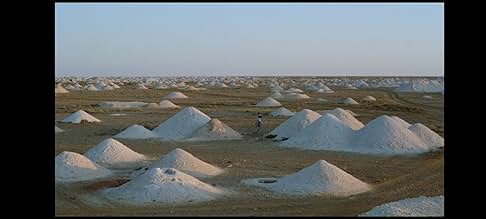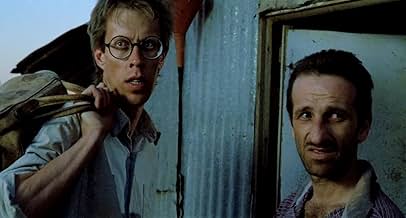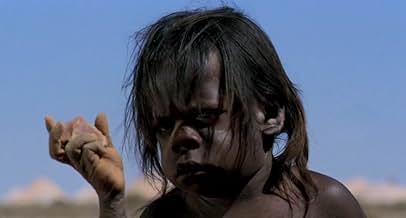CALIFICACIÓN DE IMDb
6.9/10
2.8 k
TU CALIFICACIÓN
Un geólogo contratado por una compañía minera australiana se ve envuelto en una disputa por los derechos de la tierra sagrada de unos aborígenes.Un geólogo contratado por una compañía minera australiana se ve envuelto en una disputa por los derechos de la tierra sagrada de unos aborígenes.Un geólogo contratado por una compañía minera australiana se ve envuelto en una disputa por los derechos de la tierra sagrada de unos aborígenes.
- Premios
- 2 premios ganados y 2 nominaciones en total
- Dirección
- Guionistas
- Todo el elenco y el equipo
- Producción, taquilla y más en IMDbPro
Opiniones destacadas
I also remember this film as life-changing. I saw it at the TIFF many years ago and was baffled by it.
There is a small scene in an elevator that I remember as a transcendent cinematic moment.
Like so many of Herzog's films, it is deeply moving for reasons that aren't easy to put your finger on - often with Herzog it's an odd juxtaposition, an awkward silence, a strange edit, an inappropriate flash of humour or horror that produce a flash of insight.
This film, at the time, seemed conventional by Herzog's standards, but I still left the theatre feeling slightly drugged, always a good sign.
There is a small scene in an elevator that I remember as a transcendent cinematic moment.
Like so many of Herzog's films, it is deeply moving for reasons that aren't easy to put your finger on - often with Herzog it's an odd juxtaposition, an awkward silence, a strange edit, an inappropriate flash of humour or horror that produce a flash of insight.
This film, at the time, seemed conventional by Herzog's standards, but I still left the theatre feeling slightly drugged, always a good sign.
Where the Green Ants Dream- at the least featuring one of Werner Herzog's best titled films as it's one of those amazing visuals one gets out of the strangest of the director's work- is placed in a somewhat minor cannon of the German maverick's work, and maybe rightfully so. It's about a controversial topic, that of the rights of the Aborigines and the Australian's seeming right via original British Imperial rule, and it features practically all non-professional actors and some shaky transitions between its sturdy plot and non-sequiters and quintessential Herzogian landscapes. If I were recommending Herzog films to a friend this wouldn't be at the top of the crop (unless of course one is fervently into Australian issue movies or love that one song from the 80s "Beds are Burning"). But it's by no means an over-ambitious quagmire like Heart of Glass, and at worst it's occasionally dull or, and I hate to say this for Herzog, too eccentric for its own good.
It's not to say some of Herzog's bits of character eccentricities aren't out of place. There's featured here amid the story of an aboriginal tribe peacefully protesting and standing their ground against construction on a sacred land of the title name various strange bits of business. My favorite was that mid-section involving the Aborigines asking for a plane, assumed on the part of the construction group as part of the negotiations, and features in one of the oddest parts of the movie the one black pilot from the Aussie air force who keeps singing "My baby does the hanky-panky" to himself. And there's some cool visuals of stock tornado footage and those barren wastelands and perplexing dunes and pyramid-hills in the desert plains that provide the director some choice locations to film. It's hard not to see for the Herzog fan some allotment of poetry.
But there are some problems that I couldn't quite ignore. Despite the acting force of Bruce Spence, who displays far more here as a gifted actor (contrary to what another IMDb reviewer said) and as more than just the kooky flier in the Mad Max movies, the acting is in general fairly weak and at best standard and too off-kilter. It's fairly distracting when Herzog can't quite corral his actors as well as with his technical skills; this also despite some real 'presence' with the two aboriginal chiefs. And certain big scenes, like the courtroom, aren't as effective as might have been intended and come off as dry and too naturalistic and stuffy.
And yet, even with these qualms, it's got some real courage and conviction with its message, which is that aside from the typical "respect the native culture" beat is that people need to learn to live together and not have cultures lost and squandered in the face of bigotry and imperialistic attitudes that should have been squashed decades ago. It's a very good, if not great, examination of a meeting of two societies and an identification of "the other" by a filmmaker willing to take it on. 7.5/10
It's not to say some of Herzog's bits of character eccentricities aren't out of place. There's featured here amid the story of an aboriginal tribe peacefully protesting and standing their ground against construction on a sacred land of the title name various strange bits of business. My favorite was that mid-section involving the Aborigines asking for a plane, assumed on the part of the construction group as part of the negotiations, and features in one of the oddest parts of the movie the one black pilot from the Aussie air force who keeps singing "My baby does the hanky-panky" to himself. And there's some cool visuals of stock tornado footage and those barren wastelands and perplexing dunes and pyramid-hills in the desert plains that provide the director some choice locations to film. It's hard not to see for the Herzog fan some allotment of poetry.
But there are some problems that I couldn't quite ignore. Despite the acting force of Bruce Spence, who displays far more here as a gifted actor (contrary to what another IMDb reviewer said) and as more than just the kooky flier in the Mad Max movies, the acting is in general fairly weak and at best standard and too off-kilter. It's fairly distracting when Herzog can't quite corral his actors as well as with his technical skills; this also despite some real 'presence' with the two aboriginal chiefs. And certain big scenes, like the courtroom, aren't as effective as might have been intended and come off as dry and too naturalistic and stuffy.
And yet, even with these qualms, it's got some real courage and conviction with its message, which is that aside from the typical "respect the native culture" beat is that people need to learn to live together and not have cultures lost and squandered in the face of bigotry and imperialistic attitudes that should have been squashed decades ago. It's a very good, if not great, examination of a meeting of two societies and an identification of "the other" by a filmmaker willing to take it on. 7.5/10
The geologist Lance Hackett is employed by an Australian mining company to map the subsoil of a desert area covered with ant hills prior to a possible uranium extraction. His work is impeded by some aborigines who explain that this is the place where the green ants dream.
Werner Herzog makes great films, and he is quite prolific in what he does. His career sees to be divided between unusual drama and documentaries of different cultures. This film, perhaps more than any other of his work, really blends the two. While not a documentary, it really tries to celebrate aborigine culture.
Of all the films based in Australia, this is one of the better ones. It may not be reality, but it is in some ways better than reality. Herzog creates a world that is completely believable.
Werner Herzog makes great films, and he is quite prolific in what he does. His career sees to be divided between unusual drama and documentaries of different cultures. This film, perhaps more than any other of his work, really blends the two. While not a documentary, it really tries to celebrate aborigine culture.
Of all the films based in Australia, this is one of the better ones. It may not be reality, but it is in some ways better than reality. Herzog creates a world that is completely believable.
I really liked this movie. I liked the respect that was offered and given by both the native demonstrators and the geologist. This film prompted thought, thought about what is valued when death approaches, whether that is seen as death of an individual or a people. The mining company stands on the foundation of its legal right to proceed with what the contemporary civilization values, and some scoff the values of the natives. But if we listen we hear that is something we all must address when asking of ourselves what is sacred and will we protect and defend that in the face of our own extinction, because clearly the law is not designed to protect the sacred, but to settle a dispute. We are an amalgam of the characters, the native voice that seeks self perpetuation of tribe and story, the company voice that works for progress and acquisition of wealth, the mediator and thinker voice that comes through the geologist, and the law which strives of order in chaos. These tensions of the human condition, are made so vivid in the land and skies of the Australian outback.
I'm invariably surprised when I mention this film to friends that they say they've never seen it. Werner Herzog in Australia? C'mon. How could the great German director of Wozzeck, Nosferatu and other Gothic classics concern himself with a very oblique tale of a development project impeded by Aboriginal Australians who contend that disturbing the green ants dreams by ripping up their habitat will likewise rip the fabric of the universe? The government solution is to give them an airplane which one of the younger members of their tribe eventually manages to take off with a number of the elders on board. Looking over the cast, you likely not recognize names that most of us who don't follow Aussie films know; some of us may know Bruce Spence from the Mad Max films who plays a geologist, but there are many Australian Aborigines. A poignant moment is seen in the court room scene where one Aborigine rises to speak and the judge asks for a translation, only to be told the men is called "the Mute" because there's no one left who understands his tribal language.
The overall effect of the film is wonderfully Herzog with a surrealistic portrayal of the clash of old and new, progress versus conservation and fraught with cultural miscommunication. I really recommend this film for your viewing.
The overall effect of the film is wonderfully Herzog with a surrealistic portrayal of the clash of old and new, progress versus conservation and fraught with cultural miscommunication. I really recommend this film for your viewing.
¿Sabías que…?
- TriviaThe whole story of the green ants was made up by Werner Herzog, it's not a part of genuine Aboriginal folklore. However the courtroom incident where a secret artifact is revealed, to the bemusement of the judge, is based on a real incident.
- Citas
Lance Hackett: The situation, your Honor, is this man is the the sacred custodian to the secrets of this tribe. And his tribe has died out. He is the sole and final survivor of his people, his clan. They call him the mute, because there is nobody left on this earth for him to speak with.
- Bandas sonorasRequiem Op. 48
Music by Gabriel Fauré
Selecciones populares
Inicia sesión para calificar y agrega a la lista de videos para obtener recomendaciones personalizadas
- How long is Where the Green Ants Dream?Con tecnología de Alexa
Detalles
- Fecha de lanzamiento
- País de origen
- Idioma
- También se conoce como
- Where the Green Ants Dream
- Locaciones de filmación
- Productoras
- Ver más créditos de la compañía en IMDbPro
- Tiempo de ejecución1 hora 40 minutos
- Mezcla de sonido
- Relación de aspecto
- 1.85 : 1
Contribuir a esta página
Sugiere una edición o agrega el contenido que falta

Principales brechas de datos
What is the Spanish language plot outline for Donde sueñan las hormigas verdes (1984)?
Responda





























